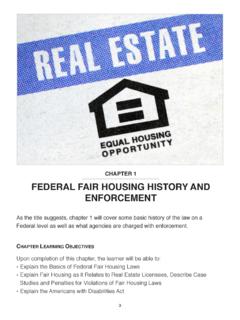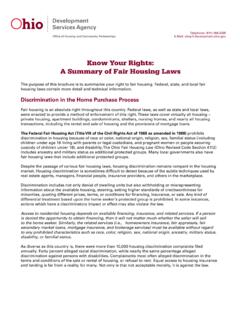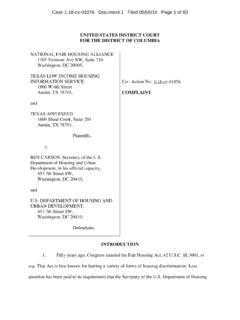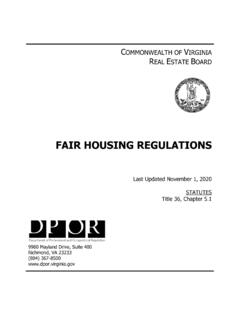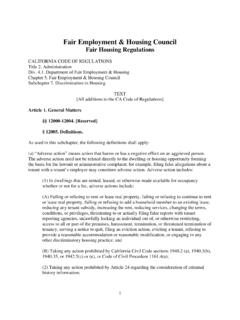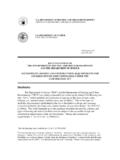Transcription of RURAL FAIR HOUSING COMPLAINTS AND ENFORCEMENT
1 HOUSING Assistance Council Phone: (202) 842 8600 1025 Vermont Ave., NW Fax: (202) 347 3441 Suite 606 E mail: Washington DC 20005 RURAL fair HOUSING COMPLAINTS AND ENFORCEMENT HOUSING Assistance Council $ March 2011 HOUSING Assistance Council 1025 Vermont Avenue, Suite 606 Washington, DC 20005 202-842-8600 (voice) 202-347-3441 (fax) (e-mail) ISBN: 978-1-58064-165-4 This report was prepared by Stella Edosomwan of the HOUSING Assistance Council (HAC). The work that provided the basis for this publication was supported by funding under Cooperative Agreement H-21564 CA with the Department of HOUSING and Urban Development (HUD).
2 Ndeye Jackson service as Government Technical Representative. The substance and funding of that work are dedicated to the public. HAC is solely responsible for the accuracy of the statements and interpretations contained in this publication and such interpretations do not necessarily reflect the views of the United States Government. HAC, founded in 1971, is a nonprofit corporation that supports the development of RURAL low-income HOUSING nationwide. HAC provides technical HOUSING services, loans from a revolving fund, HOUSING program and policy analysis, research and demonstration projects, and training and information services. HAC is an equal opportunity lender.
3 Iii TABLE OF CONTENTS Executive Summary .. 1 Introduction .. 3 Background .. 3 Methodology .. 6 fair HOUSING COMPLAINTS .. 8 Protected Classes .. 8 Issues of Discrimination .. 9 RURAL fair HOUSING COMPLAINTS .. 10 RURAL ENFORCEMENT in Practice .. 17 Mason City Human Rights Commission .. 18 Arizona fair HOUSING Center .. 19 fair HOUSING of the Dakotas .. 20 fair HOUSING Center of West Michigan .. 21 Trends .. 24 Best Practices .. 24 Bibliography .. 26 HOUSING Assistance Council 1 EXECUTIVE SUMMARY For more than 40 years, federal fair HOUSING laws have helped to decrease the levels of discrimination previously found in the rental, sale, and financing of HOUSING .
4 Despite the long record of activism on fair HOUSING issues in general, very little is known about RURAL fair HOUSING . To better understand fair HOUSING trends in RURAL communities, HAC analyzed over 91,000 fair HOUSING COMPLAINTS in HUD s TEAPOTS dataset. The analysis of TEAPOTS data includes information on the number and types of fair HOUSING violations filed with HUD and FHAP agencies in RURAL counties from fiscal year (FY) 1998 to FY 2008. Of the 91,030 fair HOUSING COMPLAINTS analyzed for this research, slightly more than 13 percent (12,261 COMPLAINTS ) were filed for alleged discriminatory actions in RURAL communities. Several trends related to RURAL fair HOUSING COMPLAINTS were identified through this analysis.
5 Portion of HOUSING discrimination COMPLAINTS originating in RURAL communities. HAC s analysis of TEAPOTS data shows that approximately 13 percent of all COMPLAINTS filed are based on discrimination that occurred in a RURAL county. The proportion of RURAL COMPLAINTS has remained constant over the last decade. Processing of RURAL COMPLAINTS . HUD offices are responsible for processing a greater proportion of RURAL COMPLAINTS as compared to urban COMPLAINTS , indicating that many RURAL areas may not be within FHAP jurisdictions. For example, largely RURAL states like Mississippi, Alabama, Wyoming, Montana, New Mexico, South Dakota, Nevada, and Alaska have not enacted substantially equivalent fair HOUSING laws, and are therefore not participating in FHAP.
6 As a result, HUD investigates HOUSING discrimination COMPLAINTS that arise in these states. Geographic concentration of RURAL COMPLAINTS . A significant proportion of RURAL COMPLAINTS are filed in specific HUD regions ( , Regions IV, V, VI, and VII). While this is consistent with larger geographic patterns, it may suggest the need for additional capacity to address these needs. Basis and issue of RURAL COMPLAINTS . For the most part, RURAL fair HOUSING COMPLAINTS are similar to urban COMPLAINTS in terms of both basis and issue. RURAL disability COMPLAINTS have increased over the last five years and disability has replaced race as the major basis of complaint.
7 In addition to analyzing fair HOUSING violations, HAC also conducted two case studies of RURAL fair HOUSING organizations. fair HOUSING providers from Michigan, the Dakotas, Iowa, and Arizona provided insight as to the challenges they face in addressing HOUSING discrimination and the best ENFORCEMENT strategies and tools in RURAL areas. While the ENFORCEMENT experiences of these providers vary, there are several lessons learned that can be gleaned from their work. Partnering with community stakeholders and creating strong partnerships can facilitate greater outreach and improved ENFORCEMENT . Several providers made the case that fair HOUSING ENFORCEMENT is an issue of trust, as complainants must feel that fair HOUSING providers will follow through on their claims and not exacerbate the conflict.
8 Residents must view the organization as a reliable source of support and assistance. This can be achieved by working closely with trusted partners in the community. The creative use of local realtors and law students to identify fair 2 RURAL fair HOUSING COMPLAINTS and ENFORCEMENT HOUSING cases or discriminatory advertisements increases the reach of the fair HOUSING organization and improves its reputation in the community. Outreach and education efforts must be customized and directed to local stakeholders in order to overcome antipathy and indifference towards HOUSING discrimination. Education efforts are difficult in RURAL communities, specifically because of the large geography many organizations cover.
9 RURAL providers noted that innovative outreach strategies can be used to share lessons with both victims and perpetrators of HOUSING discrimination. Conciliation agreements can be shared with those accused of fair HOUSING violations as an educational tool to help them understand how they can address their issues and also with victims to help them see the results of COMPLAINTS . Effective testing requires knowledge of local culture and dynamics. Practitioners recognize the challenges of fair HOUSING testing in RURAL communities; however, each of the providers interviewed used fair HOUSING tests. Providers noted that testing can work in communities when there is a genuine knowledge of the community and an understanding of local culture.
10 Testing must also be done in coordination with education and outreach in order to be most effective. HOUSING Assistance Council 3 INTRODUCTION Both the fair HOUSING Act and the fair HOUSING Amendments Act have moved the nation closer to the goal of ensuring equal HOUSING opportunities for all. fair HOUSING laws have helped to decrease the levels of discrimination previously found in the rental, sale, and financing of HOUSING (HUD 2007c). However, the 10,552 fair HOUSING COMPLAINTS filed in 2008 demonstrate that HOUSING discrimination still exists in communities across America (NFHA 2009).i RURAL communities have traditionally been more homogenous than urban America (HAC 2002) and this has led some to assume that fair HOUSING issues are not as prevalent.
